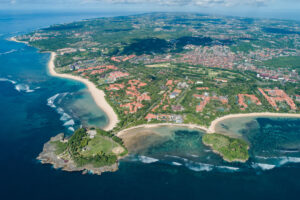Bali’s Hospitality Design: Between Paradise and Profit
Bali’s hospitality architecture is more than just buildings , it is the story of how a century of tourism shaped the island’s cultural identity. From the colonial-era Bali Hotel in 1928 to today’s eco-luxury bamboo resorts, architecture has mirrored the island’s transformation into a global destination. The Bali Style , open-air pavilions, handcrafted details, and harmony with nature , became a worldwide design export. Yet rapid tourism growth risks homogenization, threatening the very identity that makes Bali unique. This article traces 100 years of Bali’s architectural journey, exploring how culture, tourism, and sustainability intersect to shape the future of design in one of the world’s most beloved islands.
Bali is one of the world’s most recognizable travel destinations, not only for its beaches and rice fields but also for its architectural identity. From the first Bali Hotel opening in Denpasar in 1928 to the luxurious eco-resorts of today, the island’s design journey has been shaped by colonial influences, local traditions, and global tourism demands. The story of Bali’s hospitality architecture is also the story of its people, economy, and cultural survival. This article traces a century of transformation in Balinese architecture, exploring how tourism shaped the built environment, why the “Bali Style” became a global brand, and what is at stake for the future of authenticity and sustainability in hospitality design.
A Century Ago : The Birth of Bali’s Architectural Tourism
Bali’s hospitality architecture story begins with the steamship routes of the early 20th century. When Bali was connected to major Dutch East Indies cities in 1924, it opened the door to a new kind of cultural exchange. Four years later, the Bali Hotel in Denpasar became the island’s first international accommodation.
- The Bali Hotel symbolized the first attempt to create a “modern” structure for tourists, integrating colonial design influences while experimenting with Balinese decorative motifs.
- Early visitors included artists, anthropologists, and colonial elites , people fascinated by Bali’s temples, rituals, and natural landscapes. Their presence encouraged the adaptation of local compounds into guesthouses and eventually inspired resorts that fused Balinese and European styles.
This was not just about architecture , it was the start of Bali’s economy being tied to hospitality. The built environment became a stage where culture was displayed for visitors, and architecture became a bridge between global curiosity and local tradition.
Independence Nation Building and Tourism Expansion
After Indonesia gained independence in 1945, Bali became a stage for national identity and international tourism growth. The Bali Beach Hotel, inaugurated in 1966 in Sanur, represented this new era. Built as a modernist high-rise with foreign influence, it sparked debates: was this progress, or was it cultural erasure?
The backlash to Bali Beach Hotel led to significant architectural shifts:
- Architects and hoteliers like Geoffrey Bawa, Peter Muller, and Made Wijaya pioneered a contextual approach. They embraced Balinese forms, natural ventilation, and local materials, while adapting layouts to international comfort standards.
- Tandjung Sari in Sanur, started as Wija Waworuntu’s home, became a model of “intimate hospitality” — modestly scaled, deeply Balinese, yet welcoming to the global traveler.
- This period gave rise to what became known worldwide as the “Bali Style”: open pavilions, alang-alang thatched roofs, carved stone walls, bamboo, and an emphasis on gardens as living spaces.
Nation building and cultural diplomacy were inseparable. Hotels were no longer just places to sleep; they became architectural ambassadors of Indonesia’s cultural richness.
The Rise of the “Bali Style” as a Global Design Movement
By the 1980s and 1990s, Bali was firmly established as a luxury destination. International hotel groups like Aman, Four Seasons, and Hyatt embraced the Bali Style as a brand identity.
- Amandari and Amankila, spearheaded by Adrian Zecha with architects like Kerry Hill, set new benchmarks for luxury resorts. They presented “Balinese luxury” as intimate, nature-connected, and handcrafted.
- Potato Head Suites (formerly Katamama) and newer boutique hotels extended the style into contemporary design, using traditional craftsmanship in modern forms.
- Balinese design elements , from open-air bale structures to the use of paras (limestone) and bamboo , became globalized. Villas in Greece, eco-lodges in Costa Rica, and spas in Dubai began to borrow from Bali’s design language.
At this point, Bali wasn’t just following trends , it was exporting its architectural identity worldwide.
Globalization and the Challenges of Homogenization
Tourism brought prosperity, but also pressure. With over 17,000 accommodations now listed on Booking.com in Bali, homogenization became a concern.
- Too many new villas and hotels chased aesthetics instead of authenticity, leading to what Radit Mahindro called “abstract manifestations of ego” , buildings disconnected from culture and site.
- Overdevelopment strained infrastructure: water scarcity, traffic congestion, and waste management challenges worsened.
- Local communities often faced displacement, as land was commodified to satisfy the demand for foreign-owned villas.
The lesson here is clear: when tourism dictates design without balance, the island risks losing the very identity that makes it attractive.
Traditional Principles That Keep Authenticity Alive
Traditional Balinese architecture is not static , it evolves, but always with guiding philosophies. Two important frameworks are:
- Asta Kosala Kosali: Balinese guidelines on proportion, space orientation, and symbolic alignment with nature and spirituality.
- Asta Bumi: Principles that ensure harmony between buildings and natural elements like rivers, mountains, and unseen energies.
These rules ensure that every structure feels grounded in its location, rather than imposed on it. The result is architecture that breathes with the island , a vital lesson for today’s global hospitality market.
Biophilic and Sustainable Luxury
In the 21st century, “eco-luxury” became the new aspiration. Bali has been at the forefront:
- Green School Bali and Ibuku’s bamboo architecture showcase how natural materials can define futuristic, sustainable spaces.
- Resorts like Bambu Indah and Fivelements integrate riverside ecosystems, organic farming, and traditional healing into hospitality design.
- The concept of luxury shifted: true exclusivity now means low-impact, high-craft experiences that reconnect guests with nature and culture.
This is an evolution of the Bali Style, showing that heritage and innovation can coexist.
The Concept of “Destinationism” vs Tourism
One of Mahindro’s most interesting contributions is the rejection of the word “tourism.” Instead, he advocates for destinationism , development that respects local culture, ecology, and people.
Examples:
- In Japan, Kyoto’s Ishō-hō (Design Act) regulates architectural identity to preserve “Japan-ness.”
- Bali could adopt similar models to ensure new hotels respect local aesthetics, water use, and social balance.
The Future of Bali Hospitality Architecture
Looking forward, Bali faces both opportunity and risk:
- Opportunities: leading global sustainable design, exporting Bali’s craft-driven architecture, and strengthening cultural tourism.
- Risks: uncontrolled development, investor-driven homogenization, and loss of identity.
If Bali embraces contextual, sustainable, and community-centered architecture, it can continue to thrive as both a global brand and a cultural sanctuary.
Bali’s hospitality architecture tells the story of resilience, adaptation, and cultural negotiation. Over the past century, the island has transformed from simple compounds to a global luxury destination, exporting its style across the world. But the essence of Balinese architecture is not just in thatched roofs or carved stone , it is in balance: between human and nature, culture and commerce, tradition and innovation.
For Bali to safeguard its design identity, future hospitality must be built not only for tourists but also for the island’s own people and environment. Only then will “Turning Opportunity into Reality” continue to resonate as more than a slogan , it will be the philosophy guiding Bali’s place in the world.






